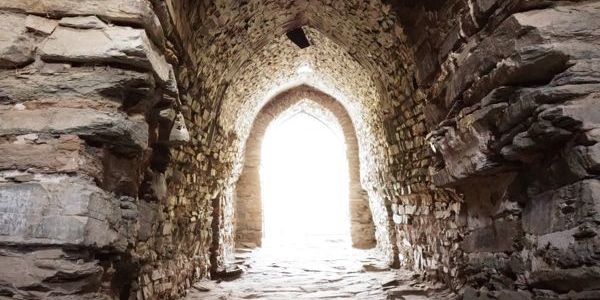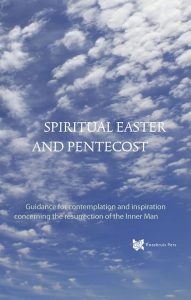MONDAY BEFORE EASTER: GOING THROUGH THE GATE
Humanity of 2,000 years ago had a very different consciousness than today’s humanity. Around the beginning of our era rational, linear thinking was much less developed than today. Partly because of that Jesus spoke to the multitudes in parables. Jesus’ disciples belonged to the few who could understand the parables not only mythically, but also intellectually.
Nowadays it is often thought that myths were there for the people of the distant past. In our modern times we think that we do not need them anymore, because we now have a well-developed intellect which allows us to understand and reason out everything. Myths are often seen as products of the imagination of the so-called primitive human being.
Actual myths, however, are not fantasies but revelations of deep truth originating from living experience. Myths stem from the domain of the human soul, also called the world of archetypes. Based on their inner longing, people who are able to raise their consciousness to this region experience universal truths reaching beyond the ordinary mind.
If we ignore myths and approach everything in life exclusively from our ordinary sense and understanding, we ignore an essential part of our being human. The mental consciousness does not replace the mythic consciousness, but it joins it, just as other forms of consciousness will develop: the human being is not yet complete.
We can only fully be human beings who are ensouled by the spirit when, on the basis of a receptive heart, we are open for the mythical, for the intuitive and for other forms of consciousness that we do not yet know.
More and more historians who have studied the life of Jesus have come to the conclusion that the Gospel narratives about Jesus are chiefly mythical and contain elements of the mythical god-man who is found under different names in the ancient mystery religions.
In Egypt the mythical god-man was Osiris; in Greece, Dionysus; in Asia Minor, Attis; in Syria, Adonis; in Italy, Bacchus; and in Persia, Mithras. For example the theme of suffering, death and resurrection already existed in the primeval myth of the Egyptian god Osiris.
A universal truth lies behind the narratives about the life of Jesus. The narratives stimulate the imagination to penetrate with our own consciousness into the world of the archetypes and the universal truths, and to comprehend the true meaning of the narratives as first-hand inner knowing.
The writer of The gospel of Philip puts it thus:
Truth did not come into the world naked, but clothed in figures and images. The world will not receive truth in any other way. There is a rebirth and an image of rebirth. It is certainly necessary to be born again through the image. Which one? Resurrection. The image must rise again through the image.
Gospel of Philip 55
The Gospels sketch with words the image of the resurrection of the inner man. This universal cosmic image is like a blueprint and has a point of contact within the outer man by means of the inner man. When in deep longing we try to fathom that omnipresent image and are prepared to attune our lives to what is being offered to us from the living tradition and the living experience, then the resurrection in ourselves can come about.
That resurrection is of a different nature than you might initially think when you take the Gospels literally. The living spiritual tradition actually approaches the Gospels from completely different principles.
The primary goal of all true spirituality is to establish and maintain a living connection between the world we live in and the world of the soul. This connection should be based on, should be longed for by human beings living on earth, both individually and collectively. Why? Because humanity can only change fundamentally when it reconnects itself consciously once more with the high divine origin from which it emerged.
Spiritual traditions teach that a human being can only form a living connection between heaven and earth when purifications and changes have taken place. These changes are rooted in deep longing, so that a subtle, spiritual body comes into being. This body is also called: soul-vesture, golden wedding garment, heavenly body, glorified body or resurrection body. The Hymn of the Pearl pictures this beautifully.
The Christian initiation mystery, which is the initiation system for the time period in which we live, presents the human being with the task of allowing the high energy of the Spirit to incarnate within himself, so to adopt a new body. There is a point of contact in the human heart for this purpose, and the cosmic spiritual force builds a new subtle body from this nucleus. Based on this new subtle body the gross-material body of the human being will undergo a process of spiritualisation.
Only in this way is it possible to receive divine powers vertically, to transmute them and subsequently to radiate them horizontally. The human being who is able to perform that spiritual work becomes like a living cross, linking the vertical dimension of the divine world with the horizontal plane of the world of matter.
Such a pupil on the Gnostic Christian path is a follower of Christ and therefore goes the road from Bethlehem to Golgotha. However, there are great differences. The Christ was a high spirit who, charged with an extremely important task for all of humanity, descended to the earth and there linked himself with the human being Jesus. If we choose to follow that spiritual gnostic path as well, in a certain sense we go that path from below upwards: by connecting with the atmospheric Christ power we are able to raise the inner man from the field of the earth into the soul field.
Jesus was the first human being on earth who went this path to resurrection, thereby completing a cosmic process that had not taken place before. Now, in our time, where there is still much room for individual philosophies of life, we can go this path openly with like-minded people. In addition, every person who takes the first tentative step on this path will receive the invisible help of all those who went the path of liberation before him.
When the end of Jesus’ life work on earth approaches, he travels with his disciples for the last time to Jerusalem to celebrate the Passover, the celebration of the entrance into the promised land. All four gospels in the Bible and chapter 67 of The Gospel of the Holy Twelve mention that Jesus enters Jerusalem on a donkey and that he is received by the people as a king, with cheering and waving of palm branches. Within the Jewish spiritual tradition this is seen as the fulfilment of a prophecy of Zechariah, who wrote centuries earlier:
Rejoice greatly, O daughter Zion!
Shout aloud, O daughter Jerusalem!
Lo, your king comes to you;
triumphant and victorious is he,
humble and riding on a donkey,
on a colt, the foal of a donkey.
He will cut off the chariot from Ephraim
and the war-horse from Jerusalem;
and the battle bow shall be cut off,
and he shall command peace to the nations;
his dominion shall be from sea to sea,
and from the River to the ends of the earth.
Zechariah 9: 9-10
Jerusalem, the spiritual capital, symbolises the ‘kingdom of the soul’, the kingdom of true unity and love. Jesus, the royal power, is received there with great joy and in gratitude because in the spiritual sense ‘he has passed through the gate’: the resurrection body has been completed.
During the journey, the physical body has been renewed by the high spiritual forces, as symbolised by the foal of a donkey on which Jesus rides into the city. In Jewish tradition, the donkey is the symbol, among others, for the planet Saturn and for the physical body. The clothes on the animal indicate that a new subtle body also came into being, the basis for the spiritual resurrection body.
And the quoted prophecy of Zechariah points out that a human being is never following the spiritual path exclusively for himself, but always for everything and everyone. To the earthly human being the result of the spiritual path is inner peace. Such peace, passing all understanding, is not confined to that one person; it has a world encompassing radiation that opens the way for all humanity to ascend to a higher plane of life.
Therefore when Jesus reaches the completely renewed state-of-being, he is able to teach in the temple out of inner knowledge. He learns that the human being in whom the soul is awakened – thus the human being in whom the son of man has come – must separate the sheep from the goats within himself. The goats symbolise the inclinations and behaviours that hinder our progress on the spiritual path. If they are recognised and acknowledged, they are burned up in the kindled fire of the soul.
The sheep symbolise our inclinations and behaviours that promote the progress on the spiritual path. The outer man who devotes himself to his inner mission visits the inner man imprisoned within him. He nourishes, refreshes and clothes that hungry, thirsty, and naked inner man, so that this one may later, prepared and equipped, pass through the gate of Jerusalem.

